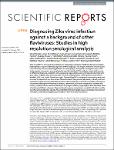Diagnosing Zika virus infection against a background of other flaviviruses: Studies in high resolution serological analysis
Hansen, Sören
Hotop, Sven-Kevin
Faye, Oumar
Ndiaye, Oumar
Böhlken-Fascher, Susanne
Pessôa, Rodrigo
Hufert, Frank
Stahl-Hennig, Christiane
Frank, Roland
Czerny, Claus-Peter
Schmidt-Chanasit, Jonas
Sanabani, Sabri S.
Sall, Amadou A.
Niedrig, Matthias
Brönstrup, Mark
Fritz, Hans-Joachim
Abd El Wahed, Ahmed
Zika virus (ZIKV) is a mosquito-borne flavivirus. Homologous proteins of different flaviviruses display high degrees of sequence identity, especially within subgroups. This leads to extensive immunological cross-reactivity and corresponding problems for developing a ZIKV-specific serological assay. In this study, peptide microarrays were employed to identify individual ZIKV antibody targets with promise in differential diagnosis. A total of 1643 overlapping oligopeptides were synthesized and printed onto glass slides. Together, they encompass the full amino acid sequences of ZIKV proteomes of African, Brazilian, USA, and French Polynesian origins. The resulting ZIKV scanning microarray chips were used to screen three pools of sera from recent Zika outbreaks in Senegal and Cape Verde, in Brazil, and from overseas travelers returning to the EU. Together with a mixed pool of well characterized, archived sera of patients suffering from infections by dengue, yellow fever, tick-borne encephalitis, and West Nile viruses, a total of 42 sera went into the study. Sixty-eight antibody target regions were identified. Most of which were hitherto unknown. Alignments and sequence comparisons revealed 13 of which could be classified as bona fide ZIKV-specific. These identified antibody target regions constitute a founding set of analytical tools for serological discrimination of ZIKV from other flaviviruses.
Dateien zu dieser Publikation

